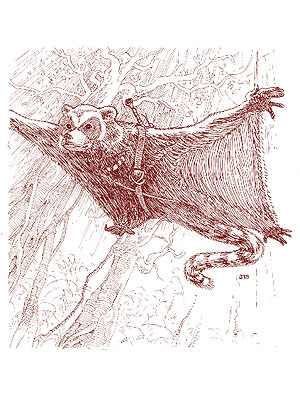
Phanaton, Jibarú
Phanatons are seldom-seen, intelligent forest dwellers that have very strong ties to nature. A phanaton looks like a cross between a raccoon, a monkey, and a flying squirrel. A phanaton is roughly the size of a halfling and has a 4-foot-long prehensile tail. In addition, a phanaton has membranes of skin stretching from arm to leg, which can be spread to glide from branch to branch.
A phanaton's coloration resembles that of a raccoon, with a dark mask over the eyes, brown-brown fur, and a ringed tail. The phanaton's hands are like a monkey's, possessing opposable thumbs. Phanaton eyes are bright green, fiery red, or shiny yellow.
Phanatons have a complex language that consists largely of hoots, chatters, and clicks. Some phanatons can also speak the languages of elves and treants.
The Red Curse: Most phanatons live outside the cursed areas. However, those who enter these areas will acquire Legacies and require cinnabryl to ward off Affliction. Many phanatons prefer to use medicines derived from Jibarú pests to alleviate the symptoms of the Red Curse.
Combat: A phanaton's gentle nature makes it slow to attack strangers, though it will fight fanatically to preserve the natural beauty of the forest. As a rule, phanatons never opt for direct attacks on larger or more numerous foes. They use their stealth skills to launch harrying sneak attacks; they are naturally quiet, which gives the opponents a -3 penalty to surprise rolls. When among trees, phanatons can move silently with a 75% chance of success. Phanatons can move up and down trees without slowing.
Phanatons hate araneas intensely and attack them on sight, casting aside all tactics and stealth. Phanatons also have an intense dislike for Herathians (unaware that the Herathians are one and the same with the hated araneas), because they have had to defend themselves from Herathian colonisation efforts over the last century. Although detrimental to individual phanatons, the Herathian incursions did force the phanatons to develop a cohesive government, codes of mutual self-defence, and a universal system of laws.
Phanatons use simple weapons such as clubs, staves, and nets. Most of their weapons are fabricated with forest materials; they rarely use metal weapons. Their favourite ranged weapon is a blowgun from which they fire poison-coated needles. Victim are paralysed for 1d6 turns unless they make a successful saving throw vs. poison. Phanatons of Jibarú also use short spears and bows. When not using weapons, they can bite for 1d4 points of damage.
When a group of phanatons is encountered, it includes a 2 HD warrior (n'chala) with 10 hit points. These phanatons have non-weapon proficiencies in gliding, each gaining a +1 bonus to the required saving throw vs. paralysis and a swoop attack. The swoop attack mode allows the phanaton to glide through the air to sneak up on an opponent (90% move silently), followed by a high-speed dive and slashing attack, inflicting double damage if successful.
In a group of 30 or more phanatons, they have a clan war chief with 3 Hit Dice, at least 15 hit points, and a +1 bonus to all damage rolls. The war chief has 2d6 n'chala as guards. If at least 300 adults are encountered, they are led by a tribal king with 8 Hit Dice, at least 50 hit points, and a +2 bonus to all damage rolls. Phanatons of Jibarú have individuals who exceed those levels and many who use magic. Most phanaton warriors are, in fact, rangers; they receive additional bonuses to the forest skills of hiding in shadows, moving silently, tracking, and hunting.
Special Abilities: Though phanatons cannot really fly, they can perform a controlled glide, carrying no more than 10 pounds while gliding. All phanatons may glide for at least one round. On the second and subsequent rounds, the phanaton must make a successful saving throw vs. paralysis each round in order to stay aloft.
Phanatons have extremely acute senses and great empathy with their forest surroundings, giving them a +2 bonus on all their saving throws while in their natural habitat.
Habitat/Society: Each tribe is made up of clans which have 3d10+10 adult members and 25% of that number of offspring. Their villages are built high in the trees on platforms of wood and woven vines connected by a network of rope bridges. The rope bridges are not suitable for man-sized or larger creatures. Any such creature attempting to use a phanaton bridge is likely to either fall off or break the bridge.
Latecomers to civilisation, phanatons are just beginning to institute a central government and systems of laws. They seem to be headed toward a collective tribal government with an advisory council of druids and shamans.
Though they do not have a written language, phanatons continue to pass down most of their legends orally. Many phanaton names are followed by a list of accomplishments by their ancestors, such as "Falling Leaf, Whose Grandfather Longflier Dropped a Rotten Egg on the Head of an Evil Herathian Mage During the Battle of Two-Burnt-Sticks."
Phanatons ally with most treants and dryads and are usually friendly with elves. Phanatons do not like humanoids that attempt to cut down forests. They try to halt timber efforts by secretly sabotaging equipment and playing annoying, non-lethal tricks on the woodcutters.
Ecology: Healthy woods and jungles are often the sign of phanaton influence. They enjoy tending the woods, cultivating plants, and ensuring that the balance of nature in their area is maintained.
Phanatons are omnivorous. They prefer to eat fruits and vegetables, but they also eat meat. They find spiders especially delicious.
Phanatons have a life span of about 80
years. Their litters have 1d6 kits that grow to maturity in about six months.
Luckily, they are fertile for only a small fraction of the year. Otherwise,
with their long life spans, quick maturity, and large litter sizes, they would
quickly outbreed most other intelligent species.
